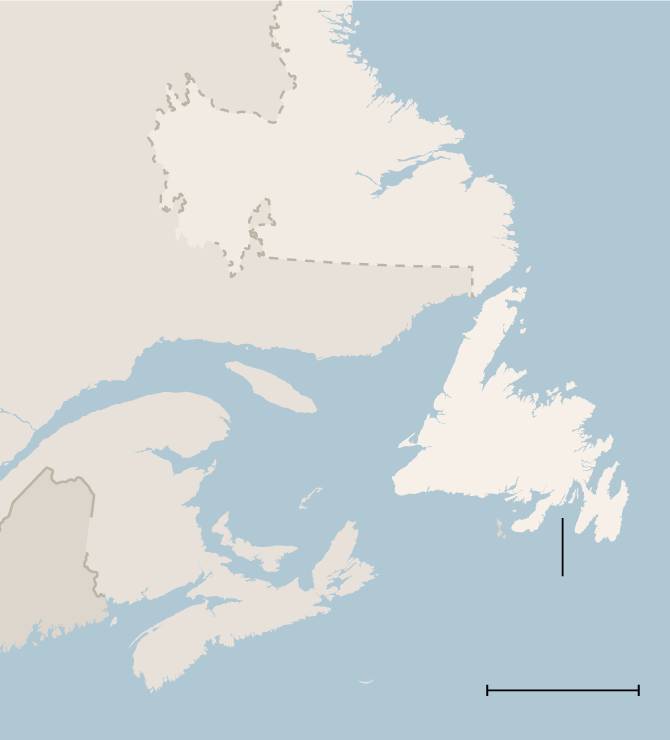A researcher thinks he knows what has been coming ashore on miles of beaches. Canada’s environmental agency says it is still looking into it.
A chemist in Canada says he has identified “with a high degree of confidence” the strange blobs that started washing up on Newfoundland’s shores months ago, although the Canadian authorities said they were still looking into it.
Globs of the white sticky substance, which have a spongy interior and range in size from a coin to a dinner plate, have been found for miles along Placentia Bay since at least September. Canada’s environmental agency began an investigation, but it has not released any conclusions.
#g-CANADA-BLOBSmap-box ,
#g-CANADA-BLOBSmap-box .g-artboard {
margin:0 auto;
}
#g-CANADA-BLOBSmap-box .g-aiAltText {
position: absolute;
left: -10000px;
width: 1px;
height: 1px;
overflow: hidden;
white-space: nowrap;
}
#g-CANADA-BLOBSmap-box p {
margin:0;
}
#g-CANADA-BLOBSmap-box .g-aiAbs {
position:absolute;
}
#g-CANADA-BLOBSmap-box .g-aiImg {
position:absolute;
top:0;
display:block;
width:100% !important;
}
#g-CANADA-BLOBSmap-box .g-aiSymbol {
position: absolute;
box-sizing: border-box;
}
#g-CANADA-BLOBSmap-box .g-aiPointText p { white-space: nowrap; }
#g-CANADA-BLOBSmap-335 {
position:relative;
overflow:hidden;
}
#g-CANADA-BLOBSmap-335 p {
font-family:nyt-cheltenham,georgia,serif;
font-style:normal;
line-height:14px;
height:auto;
opacity:1;
mix-blend-mode:normal;
letter-spacing:0em;
font-size:13px;
text-align:left;
color:rgb(98,140,178);
text-transform:none;
padding-bottom:0;
padding-top:0;
font-weight:regular;
position:static;
}
#g-CANADA-BLOBSmap-335 .g-pstyle0 {
font-style:italic;
height:14px;
mix-blend-mode:multiply;
text-align:center;
}
#g-CANADA-BLOBSmap-335 .g-pstyle1 {
font-family:nyt-franklin,arial,helvetica,sans-serif;
font-weight:500;
line-height:15px;
height:15px;
mix-blend-mode:multiply;
letter-spacing:0.05em;
font-size:14px;
color:rgb(0,0,0);
top:1.1px;
position:relative;
}
#g-CANADA-BLOBSmap-335 .g-pstyle2 {
font-family:nyt-franklin,arial,helvetica,sans-serif;
font-weight:500;
line-height:18px;
height:18px;
mix-blend-mode:multiply;
letter-spacing:0.1em;
font-size:15px;
color:rgb(0,0,0);
top:1.2px;
position:relative;
}
#g-CANADA-BLOBSmap-335 .g-pstyle3 {
font-family:nyt-franklin,arial,helvetica,sans-serif;
font-weight:500;
font-style:italic;
line-height:18px;
height:18px;
mix-blend-mode:multiply;
letter-spacing:0.05em;
font-size:14px;
color:rgb(0,0,0);
top:1.1px;
position:relative;
}
#g-CANADA-BLOBSmap-335 .g-pstyle4 {
font-family:nyt-franklin,arial,helvetica,sans-serif;
font-weight:500;
line-height:15px;
height:15px;
mix-blend-mode:multiply;
letter-spacing:0.05em;
font-size:14px;
color:rgb(102,102,102);
top:1.1px;
position:relative;
}
#g-CANADA-BLOBSmap-335 .g-pstyle5 {
font-weight:700;
font-style:italic;
height:14px;
mix-blend-mode:multiply;
}
#g-CANADA-BLOBSmap-335 .g-pstyle6 {
font-family:nyt-franklin,arial,helvetica,sans-serif;
font-weight:500;
line-height:8px;
height:8px;
mix-blend-mode:multiply;
letter-spacing:0.125em;
font-size:10px;
text-align:center;
text-transform:uppercase;
color:rgb(0,0,0);
top:0.8px;
position:relative;
}
Labrador Sea
NEWFOUNDLAND
AND LABRADOR
CANADA
NEWFOUNDLAND
Gulf of
St. Lawrence
MAINE
Placentia Bay
Atlantic Ocean
200 miles
In the meantime, researchers at Memorial University of Newfoundland, including the chemist, Chris Kozak, obtained samples and started their own inquiries.
Dr. Kozak said that one of the first things he noticed was that the blob had “a kind of petrochemical odor to it, kind of like if you walk down the turpentine aisle of your hardware store.”
At first he thought it might be polyurethane, given Newfoundland’s fishing industry and the material’s use in insulating boats. But polyurethane is less dense than water, and when it was tested, the blob sank.
